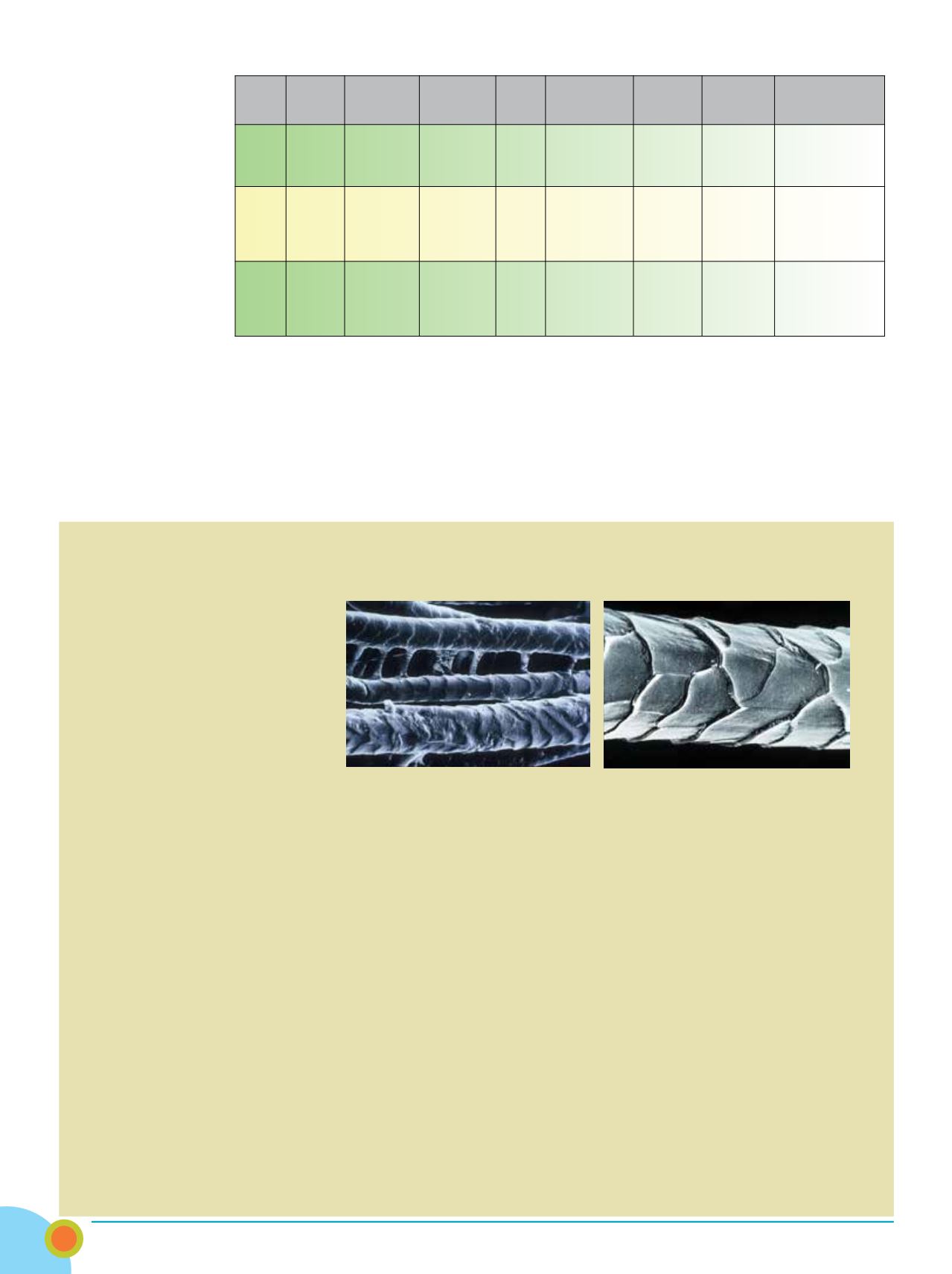

The SuperWash
debate is centered on
the chemical waste in
the process, the wa-
ter consumed and the
long-term public health
risk to low levels of
carcinogens. Ironically,
these same chemicals
essentially catapulted
the staid wool industry
into the 20th Century.
Unfortunately, as seen
time and time again with
technological advance-
ments, a leap in technol-
ogy xsometimes brings
unforeseen consequences. Although
there have been successful efforts to
address the chemical conundrum, the
majority of SuperWash is still done in
the same, not eco-friendly way, in third
world countries.
‘A’ is for Alpaca
Shawn Malloy, co-founder of Altera,
is not just a marketer. From farm to fi-
ber, Malloy knows all things alpaca and
then some. His company, Royalty Fiber
Farm and sister company U.S. Natural
Fibers, specializes in handling bou-
tique protein fibers such as alpaca, yak
and bison. For Altera, Malloy only uses
a small network of U.S. farmers con-
sidered to be in the premium alpaca
fibers space. Using these exceptional
The Dirt on SuperWash
Brand Fiber
Source
Fiber
Diameter
microns
Fiber
monolithic
or hollow
Super
Wash
Hydrophobic Anti-
bacterial
Fire
resistant
Other properties
Altera Alpaca 16-30+
Altera socks:
23-24 μm
Hollow
No
Yes
Yes
Class I fiber
by FTC/CPS
Hi loft, pills less
than wool, ½ the
moisture regain as
wool 8 v 16%
Kora Yak
18.3μm
18-20
17-25
Hollow
No
Yes
Yes
Yes
Wicking, SPF 40,
low lanolin, lower
moisture retention
than sheep, stronger
than sheep wool
United
By Blue
Bison
6-7 μm Mono
guard hair
hollow
No
Yes
Yes
n/a
Stronger tensile
strength than
merino, wicking,
high moisture
retention
Source: Bison Wool Properties; International Textiles & Apparel Association; Company reports
S
uperWash, as thought of by some
consumers, is not just pre-washed wool.
It is a process to make wool consumer
machine washable by minimizing its propensity
to shrink. A byproduct of this chemical process
is to impart better resistance to pilling and
abrasion, plus making the finished product
softer and less scratchy.
The method commonly used to do this
is the very effective Chlorine-Hercosett-
Process. At its most basic, it is a two-step
process: 1) it prepares the fiber surface for 2)
a follow-up plastic resin coating. The procedure
both reduces and covers the scales seen in
Figure 1, which without treatment, cause the adjoining fibers
to continuously interlock, ratcheting themselves ever closer
(shrinking). ZQ Merino likens the SuperWash process to hair
conditioner: it makes hair smooth and tangle-free.
As effective as it is, SuperWash does not come without serious
environmental considerations. This process requires energy, water
and has elements to it that are environmentally damaging. A 2009
European Commission study conducted by its Directorate-General
for Environment’s LIFE Programme disclosed that for 1,200
tons per annum of SuperWash wool produced, it required “150
tons of sodium hyphochlorite (household bleach), 220 tons of
polyaminoamide resin and 165 tons of other compounds such as
sulfuric (car battery) acid, wetting agents and defoamers.” These
“environmentally hazardous substances,” in combination with the
large quantities of water, form wastewater laden with significant
levels of Adsorbable Organic Halogen compounds or AOX. The
investigators found, “The AOX-loading can be up to 40 milligrams
per liter (40 ppm) and mainly due to the chlorination step, but
also from the resin treatment.”
Consequently, short of adequate water purification at the end
of the factory’s effluent pipe, water contamination by chlorine by-
products is guaranteed. In water treatment circles, many of these
contaminants are known as disinfection by-products (DBP).
DBPs created by chlorine during the SuperWash cycle have
been studied extensively but for another reason. A paper published
in 1974 by Technical University (Delft, Netherlands) researcher J.J.
Rook established a link between DBPs and sodium hypochlorite
used as a disinfectant in municipal drinking water. Rook observed
when a specific compound from sodium hypochlorite was
combined with water and organic matter occurring naturally, it
morphed into four primary THMs (trihalomethanes). As it turns out,
the compound is hypochlorous acid, the same hypochlorous acid
that revolutionized the wool industry via SuperWash.
The LIFE Programme’s final report concluded SuperWash
results could be practically achieved through other technologies
without the chemicals that form DBPs and with virtually no
water and a small increase in energy use offset by the cleaner
technology. However, as this article will show, some of the fibers
are so smooth, SuperWash is not necessary.
(Left) SEM (scanning electron microscopy) view of polymer coated wool
fiber. Note scales on the merino fiber’s surface (Right). SuperWash effectively
reduces the scale’s profile and the resin smoothes them over adding softness
and abrasion resistance. Source: CSIRO, Canberra, Australia
Inside
Outdoor
|
Summer
2016
28
















